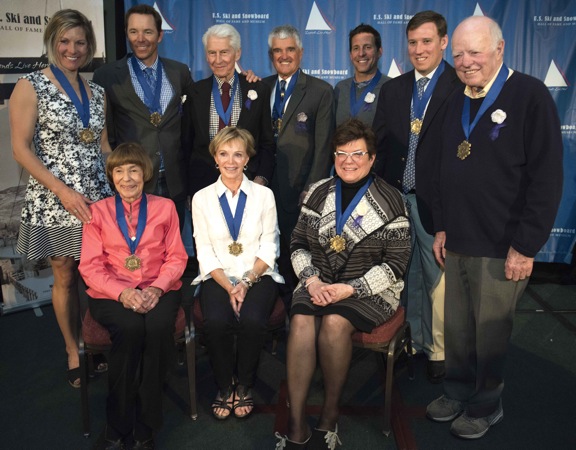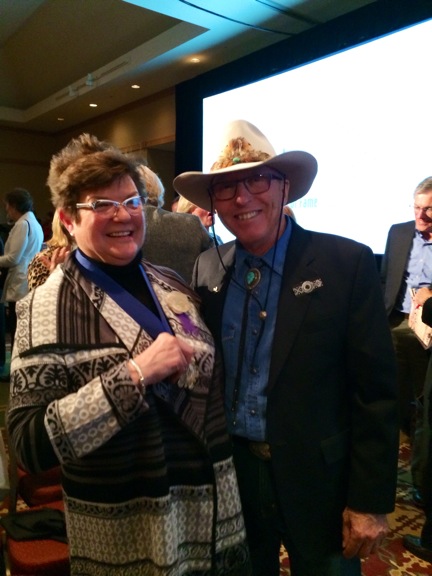UP CLOSE: Women’s ski advocate makes hall of fame

Jeannie Thoren bites into her hall of fame medal. (Photo provided)
Jeannie Thoren changed skiing, one woman at a time. And when she pulled up to the Whiteface Mountain Ski Center with her 28-foot trailer in the 1990s and 2000s, hundreds of women lined up to learn the Thoren Theory of skiing from this American pioneer.
“We used to travel around with 100 pairs of skis and 100 pairs or boots, and women would figure out what kind of ski they needed,” Thoren said.
Thoren, 68, recently sold her ski shop in Vail, Colorado, and retired to her home in Duluth, Minnesota. It was the end of the 2014-15 ski season, one highlighted by her April 11 induction into the U.S. Ski and Snowboard Hall of Fame.
Known as the “Johnny Appleseed of women’s skiing,” it is no exaggeration to say that Thoren has waited all her life to enter the hall of fame, located in the city of Ishpeming in the Upper Peninsula of Michigan, the birthplace of organized skiing in the U.S.
“My grandmother was born outside Ishpeming, and the first place I ever skied was there,” she said. “We used to go to the old ski hall of fame and look at stuff since I was a kid.”

Here are the 2014 inductees of the U.S. Ski and Snowboard Museum Hall of Fame. Back, from left: Kristina Koznick, Chris Davenport, Ralph Miller, John McMurtry, Erik Schlopy, Ross Powers and Joe Cushing. Front, from left: Betsy Chase, wife of Curt Chase, Jean Smith, wife of Bob Smith and Jeannie Thoren. (Photo provided)
—
Adirondacks
Thoren was introduced to Whiteface by a member of the Lake Placid Hall of Fame, Natalie Bombard Leduc, of Saranac Lake. Leduc is a former director on the board of the U.S. Ski and Snowboard Hall of Fame and she taught skiing at Whiteface, Mount Whitney and Mount Pisgah.
“She’s a big part of our lives,” Thoren said about Leduc. “Her enthusiasm for the sport of skiing, there’s no other woman in the United States that I’ve ever met that’s like her. There’s no one that’s that dedicated to skiing, the history, the way that it all works. She picked up on that right away, and we became very, very fast friends.”
Leduc first met Thoren through her brother, Jim Bombard, who knew her in Sun Valley, Idaho, when they lived there in the early 1970s.

Jeannie Thoren poses with ski legend Billy Kidd. (Photo provided)
In the Adirondacks, Thoren sometimes stayed in Saranac Lake, parking her black trailer at Leduc’s Mount Pisgah Road home. Other times, she stayed at the Mirror Lake Inn, and she has fond memories of the Weibrecht family and “being welcomed into the Adirondacks in true Adirondack style.”
During her trips to Whiteface, Thoren was struck by the heartiness of Adirondack women.
“They were a little bit tougher than other places where I’ve done clinics,” she said. “The one thing I remember about the Lake Placid women were that they were a go-for-it type of athlete. They weren’t shrinking violets.”
That includes Leduc, a 1948 New York state ski champion and Adirondack ski pioneer who was coached at St. Lawrence University by Wilmington ski legend Otto Schniebs.
“He used to put matchbooks under my heels to get my hips up forward, and this is the core of Jean’s teaching,” Leduc said. “She calls it ‘Women Are Not Small Men.'”
Schniebs is one of several men from the Lake Placid region in the U.S. Ski and Snowboard Hall of Fame. The others are Arthur Devlin Sr., J. Vernon Lamb Jr., Ronald MacKenzie and Godfrey Dewey. Thoren was one of 10 people inducted into the hall of fame during the April 11 ceremony in Steamboat Springs, Colorado. The others were Curt Chase (Colorado), Joe Cushing (New Hampshire), Chris Davenport (Colorado), Kristina Koznick (Colorado), John McMurtry (Colorado), Ralph Miller (Kentucky), Ross Powers (Vermont), Erik Schlopy (Utah) and Dr. Robert Smith (Idaho). There are now 404 members in the hall of fame.
—
Ski pioneer
In October 1984, Thoren changed the conversation for the entire ski industry when she began writing a column for SKI magazine called “The Woman Skier.”
“It didn’t start out that way,” Thoren said. “I just wanted to be a better skier, so I was just messing around with my equipment. I didn’t know I was going to start a revolution.”
But Thoren struck a chord with women across America. In a letter to the editor in the December 1984 issue of SKI magazine, Marina Morgenegg of Floral Park, New York, publicly thanked Thoren for her advice.
“I’ve been a skier since age three, and by the time I was doing stem christies, I was convinced that the only way to become an expert skier was to ‘ski like a man,'” Morgenegg wrote. “That method worked until I simply couldn’t ski like a man without having a sex change operation. … Thank you, Jeannie, for pointing out that the final barrier might actually be our equipment, and not the female on it.”
One of nine children born to Betty and Rolly Thoren, Jeannie was brought up in Marquette, Michigan, with a strong Scandanavian ethic.
“Work hard, help other people,” she said.
She was destined to share her new-found knowledge with the rest of the world.
“When I found out that I wasn’t the only one who needed equipment changes, I started out trying to change everybody else’s.”
Thoren held her first women’s gear clinic at Buck Hill, Minnesota in 1981. In 1986, she designed the first woman-specific ski for the Blizzard Ski Company of Austria, and she taught than 70 women’s gear clinics throughout North America from 1988 to 2006. She was recognized by Skiing Magazine as one of the 25 Most Influential People and was named one of the Top 100 Most Influential People in the History of Skiing by SKI magazine. From 2000 to 2002, she was ranked as one of the top 100 ski instructors in America.
In 2003, she received the Carson White Golden Quill Award for outstanding contribution to skiing by the North American Snowsports Journalist Association.
And in 2007, she designed the Dynastar Exclusive Carve Ski, which was named Ski of the Year by SKI magazine.
In 2009, she opened Jeannie Thoren’s Women’s Ski Center in Vail.
“It’s been a long, long journey, and it’s been fantastic, but it sure did go by fast,” Thoren said. “So the seed was planted years and years ago. Even in Lake Placid, I’m sure there’s some young girl that still remembers me being there causing a ruckus and having it work out.”
—
Thoren Theory
Natalie Leduc learned the Thoren Theory of skiing after participating in Jeannie Thoren’s women-only workshops at Whiteface Mountain, and she became a stronger skier because of it.
“I did all of the workshops because I did all the demonstrating for her,” Leduc said. “I was her assistant.”
Leduc subscribed to the Thoren Theory because it worked, and it all hinged on the balance points for women.
“We’re further back than a man,” Thoren said. “Basically, what I was working with all those years was getting women into the right balance point to use their equipment correctly.”
Picture a piece of fruit – a pear.
“What I’ve always said is that women are pears sitting on their bottoms, and men are pears standing on their heads,” Thoren said. “So we’ve got all of our weight down lower and further back, and a guy’s weight is up higher and further forward.”
Women have traditionally been too far back on their skis because those skis were originally designed for men.
“That’s been one of my missions in my life, and it’s been accomplished,” Thoren said. “One of the things about women’s skis are the bindings are mounted further forward.”
—
Passing the torch
After selling Jeannie Thoren’s Women’s Ski Center to Outdoor Divas earlier in the spring, Thoren and her husband, Tom Haas, moved to Minnesota to spend the rest of their retirement years. Haas – a former world-class cross-country skier and winner of the American Birkebeiner race – has been sick and was on oxygen 24 hours a day in the Rocky Mountains.
“We can’t be at altitude anymore,” Thoren said. “The only reason we retired is that Vail is at 8,000 feet.”
But that doesn’t mean Thoren is done with skiing.
“I still think about it all, and I will definitely ski the rest of my life, that’s for sure,” she said.
And Thoren is not done helping the ski industry. She’s still curious. And she’d like to participate in academic studies that explore the differences between men and women as they relate to skiing and equipment.
“One thing that doesn’t change is women’s builds,” she said. “You can change skis, you can change boots, you can change poles, you can change the hill that they’re on, but you can’t change a woman’s anatomical shape.”
It’s because of this one constant – the female form – that Thoren sees herself as the first, not the last, ski instructor traveling around the U.S. teaching women the Thoren Theory.
“It’s something that’s really necessary right now in this day and age for somebody to go around and do the same thing that I did because that was old equipment,” she said. “There are so many choices now. It’s like, what do you buy to ski at Whiteface? What should the width of your ski be? Eastern skis are definitely different than western skis.”
It’s time to pass the torch to a new generation of women skiers.
“The world is their oyster,” Thoren said. “I kind of plowed through and kind of kept on not backing down. … There’s only upwards to go. There are girls out there who want to do something in sports, and they don’t have to go through what I did to get as recognized. Now they can take the ball and run with it. … This is just the very, very beginning.”
- Here are the 2014 inductees of the U.S. Ski and Snowboard Museum Hall of Fame. Back, from left: Kristina Koznick, Chris Davenport, Ralph Miller, John McMurtry, Erik Schlopy, Ross Powers and Joe Cushing. Front, from left: Betsy Chase, wife of Curt Chase, Jean Smith, wife of Bob Smith and Jeannie Thoren. (Photo provided)
- Jeannie Thoren poses with ski legend Billy Kidd. (Photo provided)




